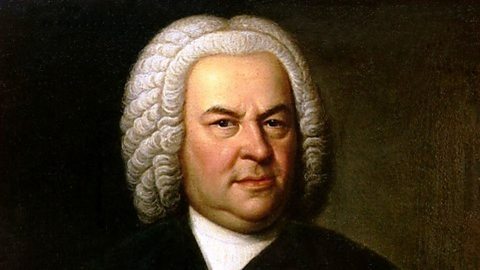James May explores the incredible details of Bach's piece, with organist Wayne Marshall.
Johann Sebastian Bach was a German musician and composer who wrote throughout the 18th Century. For most of his career, Bach worked as an organist and choirmaster at various churches throughout Germany.
What makes Bach unique is his absolute mastery of the strict compositional techniques of the day. He wrote brilliant tunes for the instruments and voices available to him at the time, but stuck to the rule-book of 18th Century music. In a lesser composer's hands, this might have sounded a bit mathematical, mechanical and boring – but not with Bach! This is especially evident in the Toccata and Fugue in D minor. It's written in two sections: the Toccata (meaning "to touch") - is a sort of free-form introduction, involving lots of fast scales and arpeggios (broken chords); the second part - the Fugue - is characterised by complex overlapping repetitions of a main theme played alongside different counter-melodies.
Listen out for: The majesty, drama and relentless rhythm the piece is known for. It's not only Bach's most famous fugue, but also the most famous fugue by any composer, ever.
Can you hear a theme or pattern (called an exposition in music) that travels around the organ 3’40” in the film. This might be repeated higher or lower. Sometimes this pattern can be turned upside down or broken. Fugue at 4’00” in whole orchestra arrangement.
Full orchestral performance: Bach's Toccata and Fugue in D minor.
Johann Sebastian Bach
Bach wrote music during a time that we now call the Baroque Period, when composers were servants who worked for wealthy families providing music for weekly church ceremonies, for parties and for special occasions. During this time composers wrote a lot and were paid little but Bach was one of the absolute best. Everything was different in the Baroque period; many of the orchestral instruments we see today hadn't been invented yet, harpsichords were the most popular keyboard instrument and music always had a purpose.
People didn't just listen to music in a concert, they used it for worship or entertainment. Bach's music was extremely complex and clever and often made up of lots of melodies weaving in and out of each other. After Bach died, Mozart and Beethoven came along and music changed again forever. Bach's music was suddenly very old fashioned and people stopped playing it. It was only in the last 100 years or so that people have started looking back to Bach's music again and noticing how brilliant he was.

MP3s: Listen to or download the music
Download the
Or download the
To save to your computer: PC - right-click and save, Mac - ctrl-click and save.

Lesson Plans
Download classroom lesson plans to explore Bach's music.To save to your computer: PC - right-click and save, Mac - ctrl-click and save.
To enable all images to work in the Powerpoint files please save the file to your computer.To save to your computer: PC - right-click and save, Mac - ctrl-click and save.
Primary lesson plans:
Lesson plan by Rachel Leach
Suitable for:
*Key Stage 2 in England and Wales
*Second Level, P5-P7 in Scotland
*Key Stage 1/Key Stage 2 in Northern Ireland
Secondary lesson plans:
Zip contains: Lesson plan, composer profile, MP3s .mp3 (organ version and orchestra versions), tips for successful remixing, example listening MP3s, samples
Lesson plan 1 written by David Ashworth.
Lesson plan 2 written by Ann Barkway.
Suitable for:
Key Stage 3 in England, Wales and Northern Ireland
Third and Fourth Level, S1-S3 in Scotland
Arrangements: Play the piece with simplified parts
All parts have been designed to work together to enable mixed-ability groups to perform together
Beginner/pre-Grade 1
- | | |
- |
- | | |
- | |
- | | |
- | | | |
- |
Grade 1-3
- | | |
- | | |
- | |
- | | |
- | | | |
- |
Grade 4-5
- | | | |
- | | |
- | |
- | | |
- | | |
- |
Combined score
Background notes on Bach arrangement
These parts have been arranged from Bach’s original work for organ, and not from the Stokowski orchestration. The piece has been cut to around half the length of the original (c. 5 minutes).
If you wish to perform this arrangement alongside the orchestration by Paul Klenovsky, the following bars will need to be CUT from the Klenovsky:
- Bar 24 to the end of the 3rd beat of bar 26;
- End of the 1st beat of 27 (using only the chord) to the 3rd beat of 35 (with semiquaver upbeat);
- 2nd beat of 47 to the end of bar 78;
- 3rd beat of 19 to the end of bar 90;
- Bars 99 – 120 inclusive;
- 3rd beat of bar 140 to everything in bar 143 except the final quaver.
Original instrumentation
In case you're considering using parts from Paul Klenovsky’s orchestration together with these arrangements, you may find the composer's instrumentation helpful:
4.4.4.4 - 6.3.4.1 – Timp, 2hp, cel – strings